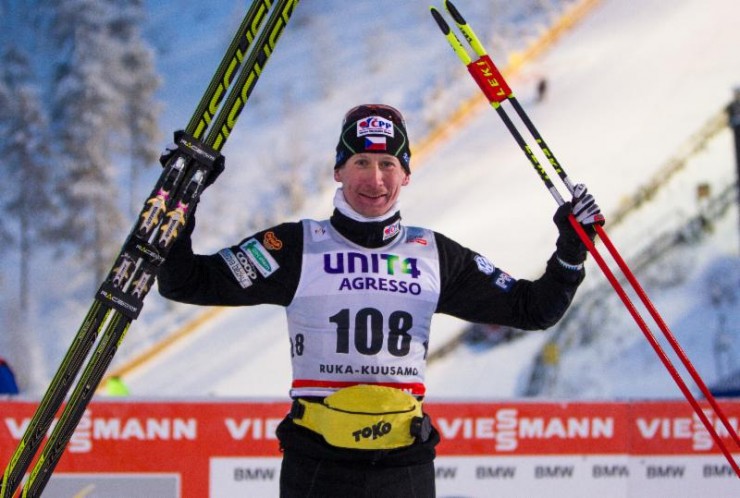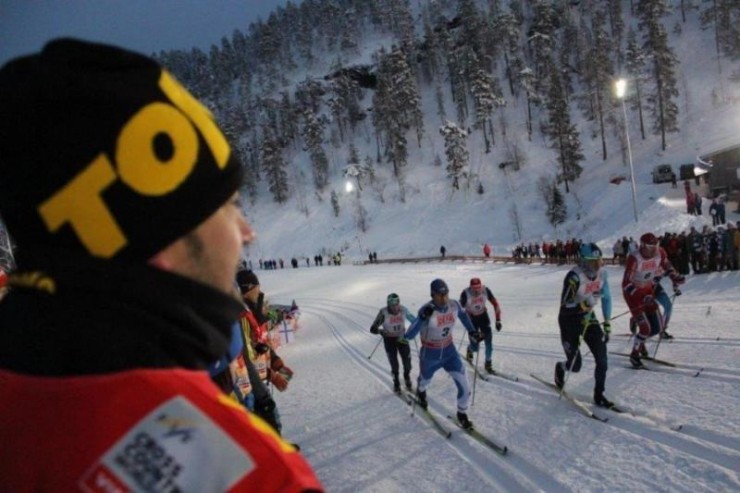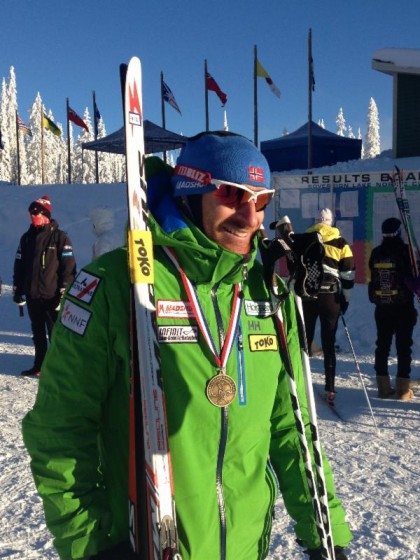Toko Athlete Lukas Bauer Wins in Kuusamo!
American Tim Burke 3rd in Ostersund!
Toko athlete Tim Burke shot clean and finished 3rd in the Ostersund Biathlon World Cup 10k race
“We were once again on Tribloc HF Blue all day long. As you saw Sam qualified 3rd so his skis were good today. Red JS was in our mix as well .” – Scott Johnston, Coach (WY Sprint)
I started the skis with a layer of HF blue. Cold powders had been running fast all week so I put Jetstream blue powder on everyone’s qualification skis. In the qualification round, the blue flouro block tested the best and was a safe choice. Since the heats were almost 3 hours after the qualification started, I knew we’d have to do some rewaxing. I was confident in the range of our under layers and powder so I concentrated on topcoats. As the sun came out and made sections of the course “greasy,” Helix red spray began to run very fast. I used that for the rest of the day on every athlete’s skis, between every heat. (WY Sprint) With the overnight lows staying significantly warmer, I opted to use a mix of HF red and blue as the base wax. Mixing these waxes offers a very large range and is a “safe” bet for an under layer. Weary of applying powder at the venue because of the increasing wind, I gambled and guessed a mix of Jetstream red and blue powder would also be good. Upon arriving at the venue, I was confident I made the right call. It’s worth noting, there was storm cloud looming with a chance of snow. I knew that if snow came, the Jetsream would run very well. After the previous day’s success, I was quick to test the Helix sprays again. Both red and blue were good, so like everything else that day, I mixed the two. I put them on very close to the start of each race because I was unsure of how the Helix would react to new snow. Luckily, the new snow never came. We had very good skis throughout the day. (WY Distance)
Testing during the week showed a graphite under layer to improve ski speed. Thus, I started with a layer of the hardest graphite I could find. After that, a layer of HF blue with the x-cold powder mixed right in. This made for a very hard base and probably would have been good enough to race on. However, I felt that the blue Jetstream powder did help ever so slightly. I ran out of test skis but, I would have liked to have tested the Jetstream blue mixed in the x-cold powder.
I did not worry about any topcoats or structure for these races instead, choosing to focus on nailing the kick.
During the week, finding a wax that kicked was not hard. However, keeping that wax on the skis was a different story. Applying the green binder during the race morning was near impossible. When putting it onto a cold ski (which all of them were when waxing outside at -18F degrees), it was very difficult to make the wax adhere to the ski. After 2 km of skiing, the wax AND the binder had ripped off. The problem was not the wax rather, my application methods and setup. To solve this, I added in 6 drops per ski of very cold/hard klister into the binder. I heated it together with a heat gun and cork.
This method can often add speed and durability but, sacrifice kick. I knew kick was not going to be a problem. I started with 5 layers of the x-cold green kick. I then tested the blue, which I would have expected to add more kick. Oddly enough, it was faster but had significantly less kick. I suspect it was so cold that it caused the softer blue wax to freeze and become ineffective.
Because it was a mass start classic where I value kick over ski speed, I added two more layers of x-cold green. All skiers reported excellent kick with very minimal wear. An added bonus was that our skis also seemed to be gliding as well as anyone’s. That’s a great bonus when focusing on kick! (Bozeman) – Gus Kaeding, Head Coach
Team Gregg
(Congratulations to both Brian and Caitlin Gregg for qualifying for the US contingent for World Cup period 2)
West Yellowstone:
Went with a base of Toko LF Blue followed by Toko HF Blue Then we raced on another powder covered with a block. On the distance day we added structure with the Toko Red structure tool.
Silver Star (Saturday):
Temperatures were super cold and we continued to test powders and blocks. We found that LF Blue and X-cold powder ran the fastest.
Bozeman (Sunday):
We went with a race wax of Toko HF Blue. Montana State University assisted with kick wax and we found the fastest combination to be Toko Blue mixed with a fluorinated kicker. – Brian Gregg.

LF Blue with Xcold powder was the base. We tested HF Blue with cold powder as well but the LF/Xcold powder mix ran faster in the cold conditions. No flouros or top coats were running for us so we went straight on the Xcold powder/LF Blue.
For kick the green base was bomber, but a little slow on its own so we just ironed one layer in and covered it with Toko Blue. This gave great kick, but was still a hair slow so we topped it with the X-Cold grip and skis were ripping. As you saw Chelsea and Miles were pretty solid! (Bozeman) – Colin Rodgers, Head Coach

I went with an LF Blue with Cold Powder for both the Sprint Qualifier and the distance 15k skate. It was pretty good, but not lights out. The HF or any powders did not test or run that well. In the quarters we used red powder and the top end speed was very good adding that as the temps warmed. We roto corked and hand rubbed in a couple of layers. In the semi’s and the final I added a red liquid and the skis were lights out!! that helix was just hand corked in after it dryed. Dmitriy’s skis were exceptional with that add as the sun continued to warm the snow. (West Yellowstone)
In Bozeman I went with straight LF blue as a race base. For kick my binder was green base applied in two layers. I iron and cork in the first, and then add a few dots of green klister that I wipe so that the base looks just wet. Once that drys, I add one more layer of green base hand corked in. The cover kick was about 6″-8″ of mint layed in three thin layers centered under the binding bar. This worked excellent as the guys had excellent skis the whole way. If they came back for a touch up, I mixed a little blue in with the mint, but not much.
Two things were deceiving about the Bozeman snow. Though the snow was new, the base was thin and very abrasive and though the air temp was very cold, the snow was 8-10 degrees warmer. (Bozeman) – Bill Pierce, Coach











